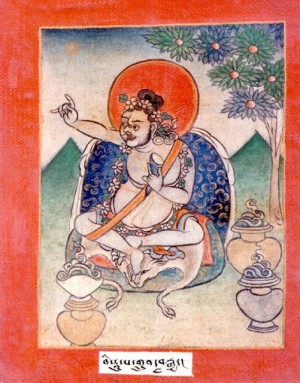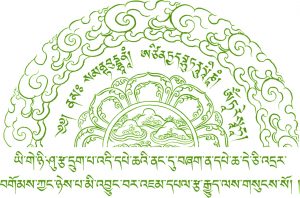Virupa entered the Buddhist monastic academy of Somapuri when he was young, here he studied and meditated, and received the initiation and empowerment of the dakini Vajra Varahi. For 12 years, he recited her mantra twice 10 million times; however he never received any sign of progress. Disgusted of him, he threw his rosary. In that evening, Vajra Varahi appeared before him and gave him a carved rosary and said:
“Child of Happiness, why are you so troubled? Keep up your practice, for you are blessed by me. If you would see clearly that things are neither this nor that, you must let go your wandering, critical thoughts. Strip your mind of illusion!” Deeply inspired, he renewed his practice for another 12 years and gained the realization of mahamudra. As he attained power over the duality of life and death, he saw no contradiction in eating meat or drinking alcohol, and when the abbot of the monastery found out he ate a pigeon pie, he was ordered to leave the monastery. He prostrated before the Buddha images and left, treading lightly from lotus to lotus on the lotus-filled lake. Upon witnessing his amazing feat, the monks prostrated to Virupa and begged him to return, they ask him why did he killed the pigeons. He replied, “That was simply an illusion, like all temporal phenomena” He then took scraps of the pigeon wing, held them and with a snap of his fingers the pigeons came back to life.
Virupa then left the monastery and became a yogin, and wherever he went, people would tell tales of his miraculous doings. One such miraculous deed was when he travelled to Devikotta in eastern India and was imprisoned by flesh-eating ghouls. In the abandoned temple where he was imprisoned, he met a young Brahmin boy who was scared and began to weep, but Virupa comforted him and blessed him with a powerful mantra of protection. At moonrise, two thugs came to fetch the boy but were unable to lift him off the ground, and so they decided to take Virupa instead. Unable to move as he was under their spell, Virupa watched the drunken ghouls brandishing their ritual knives in readiness for slaughter. Virupa then burst into laughter. Surprised, but amused, the ghouls began laughing louder, but their glee soon turned into horror when Virupa’s terrible twelve-tone bellow – the laughter of Heruka – became louder and louder until the ghouls begged him to stop. Virupa told them he would do so only if they vowed to devote themselves to the teachings of the Buddha, and when his deafening laughter rang once again, they prostrated themselves before him and swore to do his bidding. He then rose, in his right hand appeared an enormous razor-sharp discus, and behind him stood the horrific presence of the Demon of the North. Virupa then said “should you entertain the slightest thought of not renewing your pledge to the Buddha every day, expect to lose a cup of blood each day you fall from the path. And should you turn away entirely from the Buddha’s law and worship some other god, this discus will fly from the heavens and sever your head from your neck, and the Demon of the North will suck your veins dry.”
The great dakini master was not to attain ultimate liberation until he had lived seven hundred years, and at last completed, Virupa ascended to the Paradise of the Dakinis.
em
Busque no site
Busca por Assunto
Artigos Recentes

6 Máculas
Orgulho/ inveja: isto o cega para suas próprias falhas. Falta …Leia Mais »
Jamgon Kongtrul Lodroe Thaye – DA
Volume 11 11_pdf_rgya chen bka’ mdzod_da 726KB 210KB 323KB 1.57MB ‘jam …Leia Mais »
Jamgon Kongtrul Lodroe Thaye – GA
Volume 3 03_pdf_rgya chen bka’ mdzod_ga 641KB 215KB 324KB 1.72MB ‘jam …Leia Mais »
SUNGBRUM – Lord Gampopa Dhakpo Kabum
Lord Gampopa’s collected works. Many thanks to everyone who supported …Leia Mais »
Phowa
Phowa (བོད་ཡིག) é a transferência da consciência no momento da …Leia Mais »



 Cintamani - Meditação e Arte - Copyright 2020 - Todos os direitos reservados.
Cintamani - Meditação e Arte - Copyright 2020 - Todos os direitos reservados.